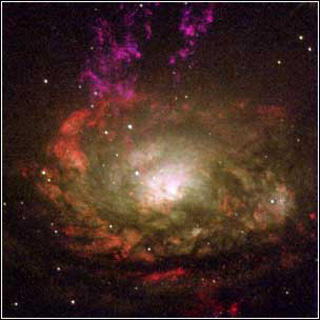Quasars remain a mystery in several key areas. These massive black holes that live at the center of distant galaxies are voracious, and we know that they can consume the equivalent mass of a thousand stars every year. Surrounded by rings of dust and gas, they light up as they pull in this material to become the fantastically bright objects we observe not just in visible light, but in infrared and x-ray light as well.
And that’s the problem. To get a count on how many quasars are out there, astronomers have measured the cosmic x-ray background, where quasars outshine everything in the universe. It should be possible to predict how many quasars there are using this method, but it doesn’t seem to work. In fact, the estimated number derived from the x-ray background doesn’t match the figures derived from x-ray and optical observations of known quasars. In other words, something is hiding many of the universe’s quasars from our view.
Now the Spitzer Space Telescope has used its infrared capabilities to see through galactic dust and identify at least some of the missing objects. Some quasars seem to be shrouded in dust in their galaxies of origin, while others are evidently positioned so their own dusty rings occlude them from Earth. But infrared sees through gas and dust, helping Spitzer researchers find 21 new quasars in a relatively small patch of sky. The finding has been corroborated by the National Radio Astronomy Observatory’s Very Large Array radio telescope in New Mexico and by the Particle Physics and Astronomy Research Council’s William Herschel Telescope in Spain. A paper presenting these findings appears in this week’s issue of Nature.
“If you extrapolate our 21 quasars out to the rest of the sky, you get a whole lot of quasars,” said Dr. Mark Lacy of the Spitzer Science Center, California Institute of Technology (Caltech), Pasadena, Calif., a co-author of the Nature paper. “This means that, as suspected, most super-massive black hole growth is hidden by dust.”
The paper is Martinez-Sansigre, A., Rawlings, S. Lacy, M. et al., “The obscuration by dust of most of the growth of supermassive black holes,” Nature 4 August 2005, p. 666.

Image: A number of massive black holes hide even in nearby galaxies, such as the Circinus Galaxy shown in this image from the Hubble Space Telescope. In the optical and ultraviolet, the properties of the galaxy are completely dominated by intense star formation and by the effects of the dust clouds seen in the image. However, hiding in its nucleus is a source of very energetic X-rays that signal the presence of a black hole. No compact source can be seen at this position in the image. Credits: NASA, Andrew S. Wilson (University of Maryland); Patrick L. Shopbell (Caltech); Chris Simpson (Subaru Telescope); Thaisa Storchi-Bergmann and F. K. B. Barbosa (UFRGS, Brazil); and Martin J. Ward (University of Leicester, U.K.).
A team at the University of Arizona led by graduate student Jennifer Donley has also used Spitzer to look for hidden x-ray sources; its work will appear in the Astrophysical Journal. The group surveyed 27 objects that could be identified as galactic nuclei, finding that fewer than half were known sources of x-rays. The rest are likely black holes hidden behind intense walls of gas and dust. All 27 of the sources lie in regions surveyed intensively by the Chandra X-ray Observatory. More in this Spitzer news release.

